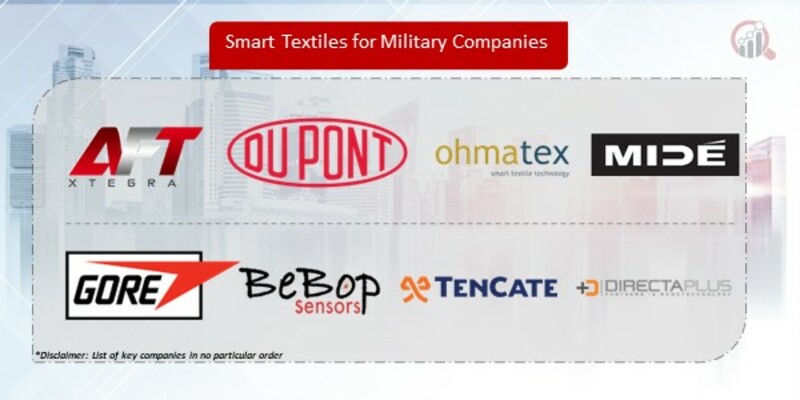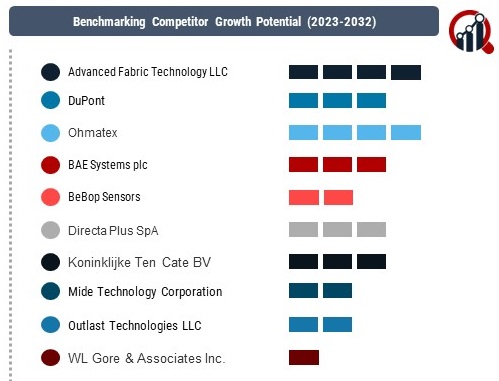Top Industry Leaders in the Smart Textiles For Military Market

Key Players and Market Share Analysis: Leading the charge in the smart textiles for military market are established giants such as :
Advanced Fabric Technology LLC (US)
DuPont (US)
Ohmatex (Denmark)
BAE Systems plc (UK)
BeBop Sensors (US)
Directa Plus SpA (Italy)
Koninklijke Ten Cate BV (Netherlands)
Mide Technology Corporation (US)
Outlast Technologies LLC (US)
WL Gore & Associates Inc. (US)
Strategies Adopted by Key Players: The strategies adopted by key players in the smart textiles for military market are diverse, reflecting the multifaceted nature of this industry. Established players like BAE Systems are actively engaged in strategic collaborations with research institutions and technology companies to leverage their collective expertise. DuPont, on the other hand, has been focusing on in-house research and development, ensuring that its material science capabilities remain at the forefront.
Innovation through mergers and acquisitions is also a prevalent strategy, as companies seek to integrate complementary technologies and broaden their product portfolios. Partnerships between textile and technology companies are becoming increasingly common, allowing for the seamless integration of electronic components into fabric. These collaborations enable a holistic approach to smart textiles, combining the strengths of both sectors to deliver comprehensive solutions for military applications.
New and Emerging Companies: The smart textiles for military market is witnessing the emergence of innovative startups that bring fresh perspectives and agile approaches to the industry. One such example is XYZ TechFab, a startup specializing in flexible electronics for textiles. XYZ TechFab's emphasis on lightweight, flexible, and scalable solutions has garnered attention in military circles, positioning it as a promising player in the smart textiles landscape.
Another notable entrant is NanoGuardian, which focuses on nanotechnology applications for military textiles. The company's advancements in creating textiles with enhanced durability, antimicrobial properties, and improved resistance to environmental factors have attracted interest from defense establishments. These emerging companies showcase the industry's trend toward specialization and the application of novel technologies to address specific military requirements.
Industry News and Trends: Recent industry news reflects the growing importance of smart textiles in military applications. Innovations such as self-healing fabrics, integrated communication systems, and adaptive camouflage technologies are making headlines. These advancements underscore the industry's commitment to providing military personnel with state-of-the-art solutions that enhance their capabilities and safety.
Additionally, there is a notable trend toward sustainability in smart textiles. Companies are exploring eco-friendly materials and manufacturing processes to align with global efforts to reduce environmental impact. This trend not only addresses environmental concerns but also resonates with military organizations increasingly focused on adopting sustainable practices.
Current Company Investment Trends: Investment trends in the smart textiles for military market reflect the optimism surrounding the industry's growth potential. Funding is flowing into research and development initiatives aimed at pushing the boundaries of what smart textiles can achieve. Companies are investing in cutting-edge technologies such as nanotechnology, artificial intelligence, and sensor integration to stay ahead of the curve.
Venture capital firms are actively supporting startups in this space, recognizing the strategic importance of smart textiles in modern military applications. Government initiatives and defense budgets dedicated to technological advancements further contribute to the influx of investments. As the market matures, investments are likely to increase, driving innovation and expanding the capabilities of smart textiles for military use.
Overall Competitive Scenario: The overall competitive scenario in the smart textiles for military market is characterized by a delicate balance between established players, emerging companies, and collaborative efforts. Established players bring years of experience and a strong reputation for reliability, while startups contribute agility, innovation, and a fresh perspective. Collaborations between textile and technology companies signify a convergence of expertise, leading to the development of comprehensive solutions that meet the complex demands of modern military applications.
As the industry evolves, adaptability will be a key factor determining success. Companies that can swiftly incorporate emerging technologies, respond to evolving military requirements, and navigate regulatory landscapes will be well-positioned for sustained growth. The smart textiles for military market is poised for expansion, driven by the convergence of advanced materials, electronics, and military applications, and the competitive landscape is set to witness further transformations in the coming years.
Textronics:
October 27, 2023: Announced a collaboration with the U.S. Army to develop a new generation of "intelligent clothing" for soldiers, integrating health monitoring sensors and environmental adaptation features.
December 19, 2023: Unveiled its latest innovation, a self-healing fabric that automatically repairs minor tears and abrasions, enhancing soldier protection and equipment longevity.
Dupont:
November 15, 2023: Secured a contract with the U.S. Navy to supply its advanced biomimetic camouflage textiles, mimicking natural surroundings for enhanced combat concealment.
September 5, 2023: Developed a new conductive yarn technology for smart textiles, enabling real-time temperature and pressure monitoring for improved soldier comfort and safety.
Milliken & Company:
October 31, 2023: Partnered with a leading medical technology company to integrate health monitoring sensors into military uniforms, allowing real-time tracking of vital signs and potential injury detection.
June 20, 2023: Launched its new line of flame-retardant and self-cooling fabrics for military applications, offering enhanced soldier protection and thermal comfort in extreme environments.


